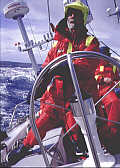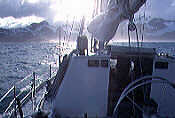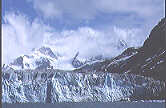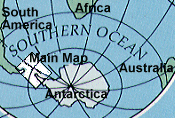
![]()
.
.
.

.
.

.
.
.

![]()

[
Logbook Index ]

Log
Entry for 29 January 1997
Position: 54-47S 35-48W.
Click map
for detailed chart
Arrival South Georgia. Pelagic at anchor Cooper Bay South Georgia.
|
On Jan 28, it is eleven days since we left Elephant Island. Shortly after midnight, the GPS says we have 100 miles to run to the southern tip of South Georgia. It is a race against the big low predicted by Bob Rice's forecast, one that is hard to believe as the weather is superb. The engine has been running for almost 20 hrs, at 0215 the wind finally fills in, so its full sail again! Mike Barry is steering and he gets 2 cups of tea made for him as a prize for being at the helm the moment we finally get Pelagic to sail. Full mainsail, full jib and staysail: we are making a good 8 kts of speed and the wind seems to be strengthening. Morning brings us a fantastic bright sunny day and a delightful downwind sail with Pelagic reaching at nine knots plus in the quartering swell. Everyone suddenly wants to steer! It's as if the boat, previously held back with tight reins while serving as a support vessel for the Tom Crean, now wants to fly like a free bird over the seas. Goose winged, the jib held out to port with the spinnaker pole and the mainsail on starboard, we are speeding towards South Georgia. Jarlath looks like a happy man at the helm in these ideal sailing conditions and seems to be recovering from the sadness of having lost his Tom Crean at sea. At 1130, Skip spots the summit of Mount Paget, the highest peak of this sub- antarctic island, poking through thick cloud on our port side. Closer in shore, near the prectipitous, inhospitable rocky cliffs and suspended glaciers, the strong smell of hidden seabird rookeries comes in gusts and fills everyone with a pleasant feeling. On 17 January 1775, when Captain James Cook made the first landing on South Georgia, he called it, "Savage and horrible. Wild rocks raised their lofty summits until they were lost in the clouds, and the valleys lay covered with everlasting snow. Not a tree was to be seen, nor a shrub even big enough to make a toothpick." As we gybe the jib and pull down the pole, a million birds appear to be circling around Pelagic. A beautiful Light Mantled Sooty Albatross, with soft blue eyes, comes to greet us personally. Tiny Wilson Storm Petrels dance gracefully on the waves. As we approach land, the wind increases and we have to reef and roll up the jib to reduce sail. Skip decides to explore some of the inlets of the south coast before heading for Cooper Bay to drop anchor for the night. The names of mountains, glaciers, coves and bays bear evidence of exploration by the British, French, Russian, and Scandinavians. We enter Smaaland Cove which has steep cliffs all around and a beautiful vertical blue glacier that falls into the sea. But the whole bay has extremely deep waters, 70- 50 meters, no place for a safe anchorage. Fierce williwaws - sudden gusts of very strong wind that blast down from the mountains and lift the water in what look like mini tornadoes - strike at us from all sides and heel Pelagic over by 20 degrees under bare poles. We proceed to explore Doubtful Bay: the pilot book speaks of a passage to the inner more protected inlet but we cannot spot it. It is quiet in this bay and the sounds of many different birds sounds like soft music. Then onto Esbensen Bay, which is surrounded by vertical dark grey crags and suspended glaciers that seem to be glued to the mountain. The mountain ridges are angry looking and rugged, not inviting at all, but the water is deep green and gives you a sense of peacefulness after having been bounced around for days by huge masses of grey water in the open sea. Before heading towards our final destination, we enter the deep fjord of Larsen Harbor. It is raining very hard by now. The weather has already changed 3 times in less than 10 hours, a characteristic of the South Georgia climate. The waters of Larsen Harbor are calm and we spot elephant and fur seals on the beach, but the wind blows in 50 kt gusts - too uninviting for a good rest. So it's time to head to Cooper Bay before it gets dark. Seven miles later we enter a round cove inside the main bay. Skip knows the area well. The sea is calm but the williwaws are still blowing at 40 kts. We are ready to drop anchor but the heavy chain, after all the rolling around at sea, has tangled up and gets stuck. Quickly, we drop Pelagics keel - previously pulled up to pass the shallow entrance of the cove - deep into the mud to hold the boat in position. Patrick goes ashore with Paddy and Jamie to secure lines on land. It's dark by now and their landings are complicated by the crowd of fur seal which inhabits the beach and rocks that surround the little cove. It's 1000 pm by the time everyone is back on board and ready for a well earned dinner. A waning big yellow moon rises behind a cliff and the sky clears again to give us a view of the southern stars we have not had for many days at sea. The sound of seals and penguins cradles everyone to sleep. It will be the first straight sleep, with no night watches, in almost 2 weeks. Elena Caputo |

